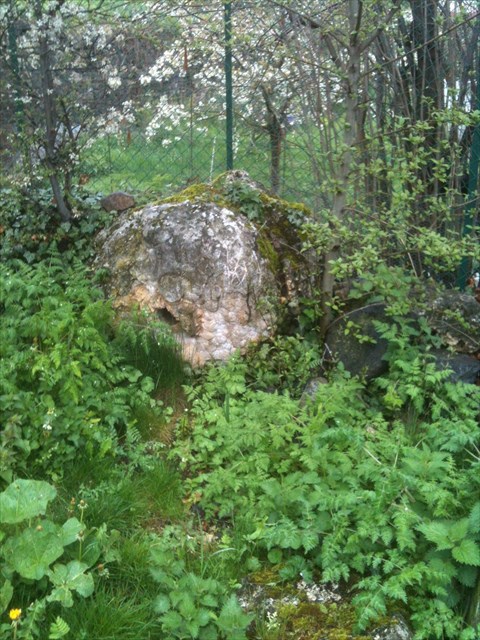Les roches stromatolithes que vous allez découvrir ici ont plus de 25 millions d’années. Ce sont des structures calcaires en forme de chou-fleur d’origine biologique.
Grace à la composition de l’eau, à la température et au processus de photosynthèse, des cyanobactéries ont permis des encroutements puis des dépôts calcaires formant des stromatolithes.
Les stromatolithes sont importants dans l'histoire de la Terre. Ce sont parmi les plus anciennes structures d'origine biologique reconnaissables .

Deux mécanismes principaux ont été identifiés :
Les cyanobactéries lors de leur croissance en colonies forment un amas de filaments bactériens qualifié de matte bactérien. Le mucilage qu'elles produisent est capable de piéger certaines des particules en suspension disponibles dans l'eau, qui finissent par former une croûte, riche en bicarbonates solubles et en carbonates de calcium insolubles qui la durcissent.
Certaines autres bactéries peuvent aussi précipiter le calcium en calcaire à l'intérieur de la cellule, en cristaux insolubles qui perdureront après la mort de la bactérie.
Les cyanobactéries qui ont constitués les stromatolithes sont en partie responsables de la dissociation du dioxyde de carbone et de l'évolution vers une atmosphère moderne riche en oxygène.
Les variétés des formes et des couleurs des stromatolithes reflètent la multitude de combinaisons météorologiques de l’époque de leur formation : vents, pluies, ensoleillement, températures ainsi que la faune et la flore de bord de grand lac. Le climat en Auvergne était alors tropical.
Ces formations témoignent de l’existence dans la plaine de Limagne d’un milieu lacustre peu profond qui s’est asséché progressivement.
Pour valider cette earth cache,
rendez-vous aux coordonnées de la cache pour répondre aux questions ci-dessous.
Loguez cette cache "Found it" et envoyez-moi vos propositions de réponses soit via mon profil, soit via la messagerie geocaching.com (Message Center), et je vous contacterai en cas de problème.
1- A quelle époque géologique le milieu lacustre s’est il asseché ?
2- Les stromatolithes sont elles des roches métamorphiques, sédimentaires ou magmatiques ?
3- Regardez autour de vous, combien de blocs de stromatolithe ont été mis à jour ?
English
This site of memory and meditation closed down in 1891 was reorganized by the municipality of saint Saturnin to discover the geology of the Plateau de la Serre . Stromatolithes rocks which you go to discover here have more than 25 million years. They are structures limestones in the shape of cauliflower of biological origin.
Thanks to the composition of the water, to the temperature and to the process of photosynthesis, cyanobactéries allowed crustings(ruts) then calcareous deposits training(forming) stromatolithes.
Stromatolithes is important in the story the Earth. They are among the oldest recognizable biological structures of origin.
Two main mechanisms were identified:
Cyanobactéries during their growth in colonies(summer camps) trains(forms) a heap of bacterial strands considered as matte bacterial. The mucilage which they produce is capable of trapping some of the available airborne particles in the water, which eventually train(form) a crust, rich in soluble bicarbonates and in insoluble carbonates of calcium which harden her(it).
Other certain bacteria can also precipitate the calcium in limestone inside the cell(unit), in insoluble crystals which will continue after the death of the bacterium.
The cyanobactéries which established(constituted) stromatolithes is partially responsible for the dissociation of the carbon dioxide and for the evolution towards a modern atmosphere rich in oxygen.
The varieties of the forms and the colors of stromatolithes reflect the multitude of meteorological combinations(overalls) of the time(period) of their training(formation): winds, rains, period of sunshine, temperatures as well as the flora and fauna of edge of big lake. The climate in Auvergne was then tropical.
These trainings(formations) testify of the existence in the plain of Limagne of a shallow lakeside environment(middle) which dried up gradually.
To validate this earth hiding place, meeting(appointment) in the address (coordinates) of the hiding place where to answer the questions below.
Loguez this hiding place " Found it " and send me your proposals of answers either via my profile, or via the geocaching.com messaging (Center message), and I shall contact you in case of problem.
1-In which geologic time(period) the lakeside environment(middle) is it asseché?
2-Is stromatolithes of the metamorphic, sedimentary or magmatic rocks?
3-Look around you, how many blocks of stromatolithe were updated?
